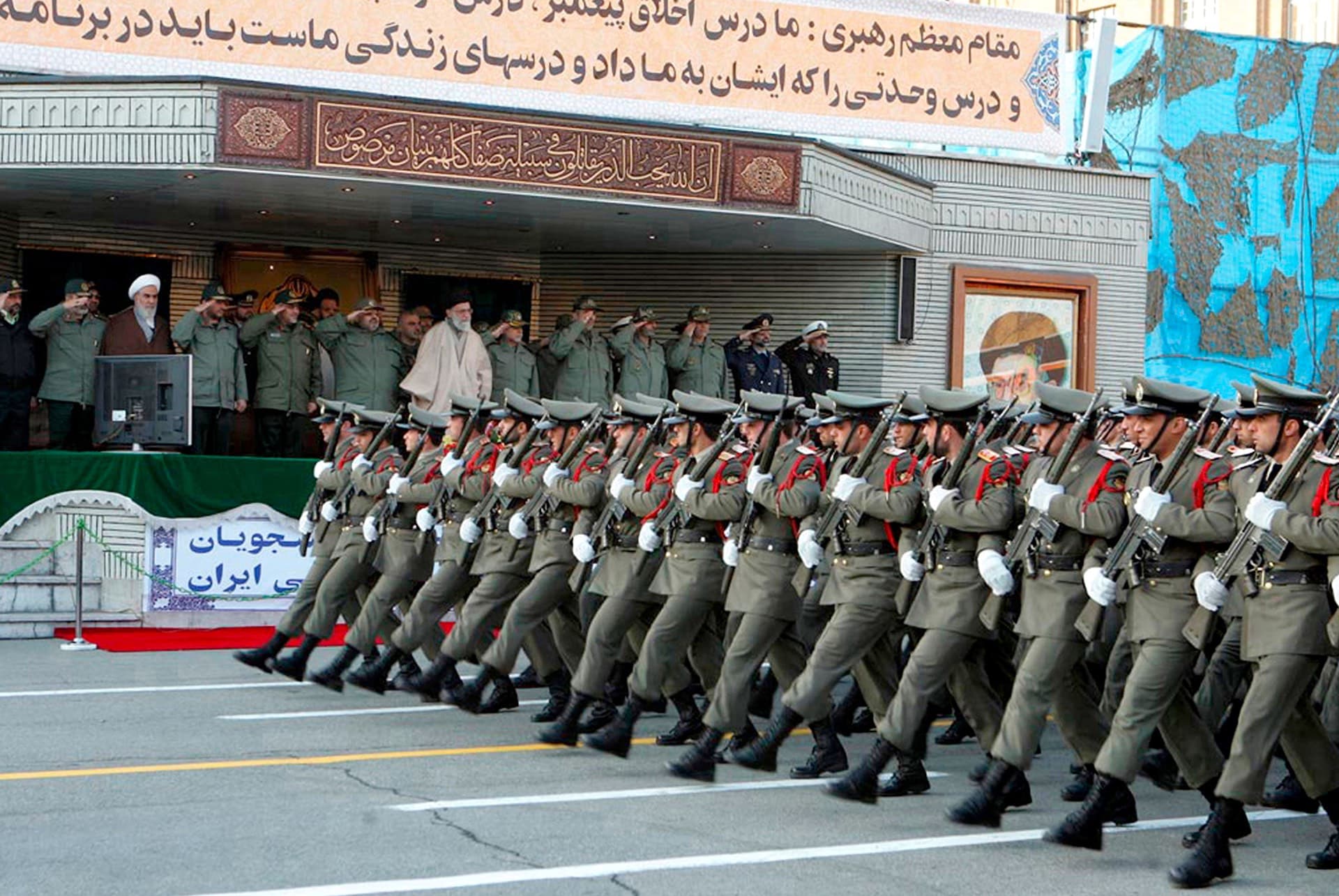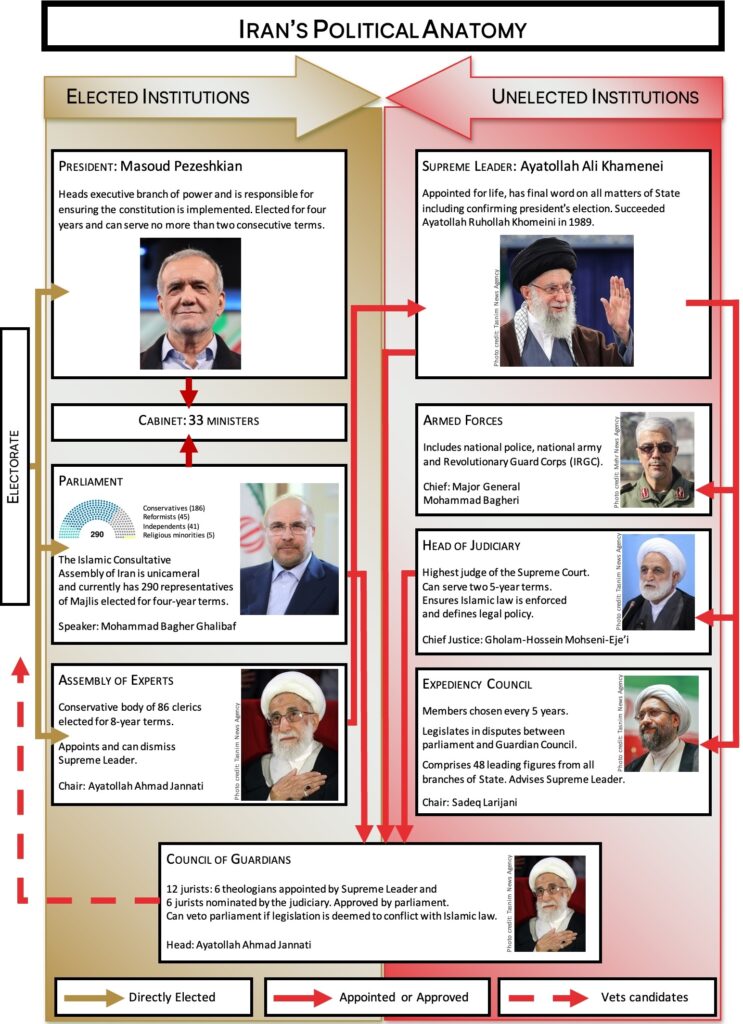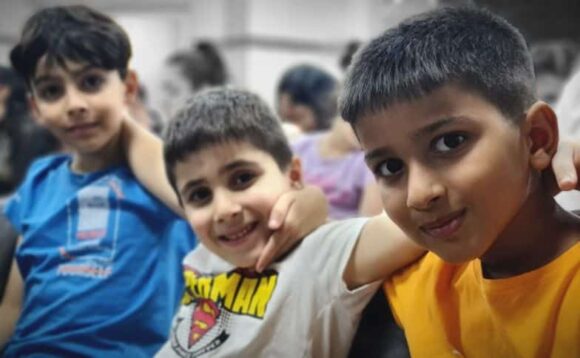
Iran’s Islamic Government – an Overview
Iran’s Islamic Government – an Overview
Establishment of the Islamic Republic and Khomeini’s Leadership
In January 1979, the Iranian Islamic revolution, led by the exiled spiritual leader Ayatollah Ruhollah Khomeini, succeeded in ending the 37-year reign of Shah Reza Pahlavi. On April 1 1979, Iran voted by national referendum to become an Islamic Republic and to approve a theocratic constitution whereby Ayatollah Khomeini became Shia Islam’s Supreme Leader (Vali Faqih) of the country in December 1979.
In December 1982, the Islamic clergy elected an Assembly of Experts to designate a successor to the Supreme Leader; in late 1985 the Assembly chose Ayatollah Ali Montazeri as Khomeini’s successor. Montazeri did not welcome the Assembly’s designation and resigned in March 1989.
Following Ayatollah Khomeini’s sudden death in June 1989, the Assembly of Experts elevated the then President Seyyed Ali Khamenei to the status of marja (Grand Ayatollah) and recognized him as the next Supreme Leader. The Supreme Leader is imbued with supreme authority in the Islamic republic, however, the authority for administration remains in the office of the president.
Eligibility and Voter Turnout in Iran’s Elections
All those over the age of 18 are eligible to vote, including women. (Voting age increased to 18 in 2007 – prior to this it had been as low as 15). The people of Iran have strong thoughts on who should lead them and use their voice when they can, particularly if it means they can make positive changes to the system. However, their confidence in the system has been decreasing over the years and turnout to elections is lower than ever before.
The 1997 elections saw a record 80% turnout as hope was high that they would be able to elect a candidate who they thought could put an end to the dictatorship or at least cause a deep rift in the country’s governance and weaken the dictator’s hold from within the system. Sadly, that was not to be. In any case, the people’s right to choose has been increasingly controlled and the 2021 elections broke records of the lowest turnout in Iranian electoral history (at around 49%). This was because the Guardian Council passed mass disqualifications of popular candidates, rendering the people without a viable choice. In addition to the low turnout, a further 13% ‘protest voted’ by submitting blank, invalid and lost votes. This is despite a declaration by the Supreme Leader forbidding protest voting (haraam). These elections also saw 42 journalists summoned or threatened for writing non-Government-sanctioned press about candidates (Reporters Without Borders). Since 2021, confidence in a democratic system continues to drop with even lower turnouts in the 2024 elections (just below 40%).
Iran’s Complex Power Structure: Presidential Limitations and Religious Influence
The president is the second-highest ranking official in the country. He can serve no more than two consecutive four-year terms. He is elected by the people. Presidential candidates are vetted by the Guardian Council. In recent years, there has been a marked increase to the number of candidates that the Guardian Council has banned or disqualified – this makes it virtually impossible for any true reformists to stand for election and has led to much protest voting.
The president has the right to choose the members of his cabinet (The Council of Ministers) but his choices must be approved by parliament (Majlis) which has on many occasions rejected candidates put forward by presidents.
Iran’s power structure is not straight forward and there are many limitations on what the President can do without support from the religious bodies, and certainly without approval from the number one most powerful figure in Iran, the Supreme Leader. See figure below for how all the various players relate to each other.
Get our newsletter
Stay up to date with what God is doing in Iran today! Get the latest prayer points, project advancements, and opportunities to get involved.
Key Appointments and Powers Held by the Supreme Leader (Vali Faqih) of Iran
It is the Supreme Leader – not the president – controls the armed forces, and Iran’s security and intelligence operations, as well as foreign policies. The Supreme Leader also appoints the head of the judiciary, six members of the powerful Guardian Council, and the commanders of all Iran’s armed forces. He appoints Friday prayer leaders (prestigious and influential positions), and the head of radio and TV (control on media). He has the final say on the president’s election. He chooses the clerics on the Assembly of Experts.
Composition, Election and Powers of Iran’s Parliament (Majlis)
Parliament comprises around 290 members, all elected by the public for four-year terms. Majlis has the power to introduce and pass laws, but all their bills have to be approved by the Guardian Council. Majlis can also summon and impeach ministers or the president.
Guardian Council’s Power to Approve or Reject Legislation and Presidential Candidates
The most influential body in Iran is the Guardian Council which consists of six theologians appointed by the Supreme Leader and six jurists nominated by the judiciary and approved by parliament. Members are elected for six-year terms but these are phased meaning half the membership changes every three years. The council has the power to approve or reject all bills passed by parliament. They also have the power to approve or reject anyone standing for election to parliament, the presidency and the Assembly of Experts.
Assembly of Experts: A ‘Rubber Stamp’ Institution?
The elected body called the Assembly of Experts appoints the Supreme Leaders and monitors his activities. If they deem him unable to fulfil his duties, they can remove him from office. Members of this body serve eight-year terms. For all its powers to monitor, question, and remove the supreme leader and the directed appointed organization under him, the Assembly has largely served as a rubber stamp organization that has never seriously questioned the actions of either of the two Supreme Leaders who have led Iran since the 1979 revolution. This is particularly poignant as the Assembly is elected by the people and should be representing the interests of the people.
This leaves three other powerful bodies: the Armed Forces, the Judiciary, and the Expediency Council.
Overview of Iran’s Armed Forces: Revolutionary Guard and Regular Forces
Iran’s armed forces comprise the Revolutionary Guard (Sepāh) and the regular forces. The Supreme Leader appoints all the leading figures here. The Revolutionary Guard was formed following the 1979 Islamic revolution and has a powerful presence across Iran’s institutions, controlling the volunteer paramilitary Basij Resistance Force with branches in every town and city. In 2002, the Iranian press reported that the Basij had between 5-7 million members, although in 2009, IRGC HR Chief Masoud Mousavi claimed there to be 11.2 million Basij.
But Western analysts put the number closer to 1 million active members, with likely several million reserves. Amongst other things, the Basij crack down on dissent.
Economic Influence of the IRGC: Controlling a Third of Iran’s Economy
The IRG has developed into a multibillion-dollar business empire having a substantial stake in Iran’s economy controlling around a third of Iran’s economy through a series of subsidiaries and trusts. The Guards’ engineering wing, Khatam-ol-Anbia (GHORB) has been awarded several multibillion-dollar construction and engineering contracts, including the operation of Tehran’s new Imam Khomeini international airport
Lack of Judicial Independence in Iran
Iran’s judiciary is not independent of political influence and their role is to enforce and define legal policy. They also nominate the six lay members of the powerful Guardian Council. The head of the judiciary is appointed by the Supreme Leader.
Expediency Discernment Council
This is an advisory body for the Supreme Leader. The council also handles any disputes between parliament and the Guardian Council. Members are appointed by the Supreme Leader.
Iran’s Political Anatomy
Update: on June 13, 2025 Major General Mohammad Bagheri, the commander overseing Iran’s army branches was killed by Israeli strikes (age 65 years). He was replaced by Major General Abdolrahim Mousavi, previously the chief of staff of the Ground Forces.


Donate Today
